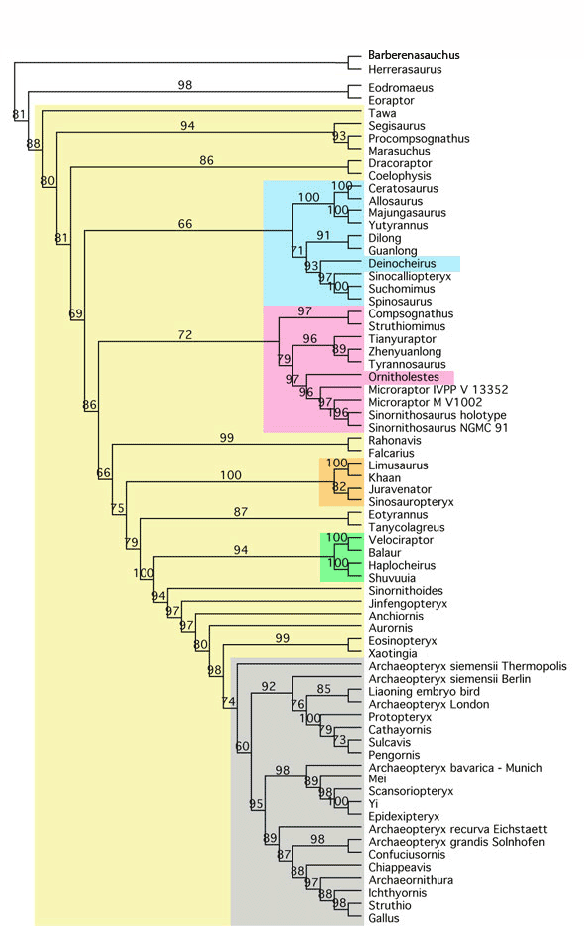

| Online: | |
| Visits: | |
| Stories: |
Ornitholestes nests with Microraptor now
Earlier we looked at a new nesting for four-winged Microraptor in the Tyrannosaurus clade. Here a close relative (Figs. 1-2) supports that nesting (Fig. 2) and calls into question the currently accepted shrinking bird ancestor hypothesis (Fig. 3).
Ornitholestes hermanni
(Ostrom 1903, 1917, 2m, incomplete skeleton, Late Jurassic, 154 mya) According to Wikipedia, “All published cladistic analyses have shown Ornitholestes to be a coelurosaur as defined by Gauthier.” A coelurosaur? That’s pretty general. As the arbiter of all that is known and accepted, can Wiki be more specific? Is Ornitholestes such an enigma? In the large reptile tree (subset in Fig. 4) Ornitholestes nests between Compsognathus and Microraptor, close to Tianyuraptor in the lineage of Tyrannosaurus. The skeleton shown here was restored based on the AMNH restoration (Fig. 1), which may not be accurate with regard to the number of cervicals and dorsals (see below).

Figure 1. Ornitholestes, as originally mounted by the American Museum and revised together with Microraptor to scale. Click to enlarge.
Ornithologist
Percy Lowe hypothesized in 1944 that Ornitholestes might have borne feathers. Now, as a close relative of Microraptor and Tianyuraptor, Ornitholestes probably had long wing and leg feathers.
Note the resemblance
of the skull of Microraptor to that of Ornitholestes (Fig. 3) and the very similar body proportions, distinct chiefly in size (Fig.1).

Figure 2. The skull of Microraptor, QM V1002. Note the resemblance to Ornitholestes.
Earlier phylogenetic studies
Wikipedia reports, “All published cladistic analyses have shown Ornitholestes to be a coelurosaur as defined by Gauthier. Some analysis have shown support for the hypothesis that it is the most primitive member of the group Maniraptora, though more thorough analyses have suggested it is more primitive than the Maniraptoriformes, and possibly a close relative of the “compsognathid” Juravenator starki.” That is not a very precise nesting. Here Ornitholestes supports the earlier hypothesis that Microraptor was not in the main lineage of birds, nor of dromaeosaurs, but this clade represents a pseudo-bird lineage that did not produce extant relatives. The pectoral girdle is not known for Ornitholestes, so we don’t know if it had long coracoids and a furcula suitable for flapping.
Behavior
Osborn (1903) originally considered Ornitholestes a bird catcher and “doubtless related as a family to Struthiomimus.” That behavior is unlikely (see below,) but the relationship is true in the large reptile tree as Struthiomimus nests with Compsognathus both proximal basal sisters to Ornitholestes.
Distinct from all tested sister taxa,
Ornitholestes had a tibia not longer than the femur, a trait that usually occurs in much larger theropods, like T-rex, but also occurs in the unrelated Sinosauropteryx.
Repairing errors
Osborn (1917) thought the referred manus specimen (AMNH 587) was not adapted to seizing or holding a struggling live prey, as he originally imagined. Pertinent to an earlier discussion, Osborn 1917 noted several inaccuracies in Osborn 1903. This was not considered just cause for other paleontologist of that – or any era – to question everything Osborn produced from then on. He corrected a mistake and everyone accepted that as what Science does.

Figure3. The evolution of birds as a consequence of miniaturization. Artist: Davide-Bonnadonna
The Shrinking Bird Ancestor Hypothesis
Earlier we looked at a paper on bird origins (Lee et al. 2014) that found a gradual size reduction in the theropod lineage that produced birds. Unfortunately, with the new cladogram, it is no longer reasonable to accept a Large > Medium > Small sequence. Rather it is more reasonable to follow a Medium > Mediium > Small hypothesis OR a Small > Small > Small hypothesis of bird origins (Fig. 4). In other words, the lineage that ultimately produced birds may have stayed small and occasionally branched off medium and large-sized clade members.

Figure 4. Here, in this subset of the large reptile tree, Ornitholestes nests at the base of the Microraptor clade, close to the base of the Tyrannosaurus clade. Every 5 seconds the graphic will change, 3 frames. Depending on how you look at it, either medium-size dinosaurs produced large and small dinosaurs, or small dinosaurs produced medium and large dinosaurs. In pterosaurs small always produced medium and large.
Of course, a more complete fossil record
could solve this problem. But at present we should not loose sight of the fact that basalmost dinosaurs, like Barberenasuchus and Eodromaeus, were small, not medium or large (depending on your definition and cut-off, of course). With Tyrannosaurus in the mix, Struthio the ostrich becomes a medium-sized theropod, even though it is a large bird. The presence of small dinosaurs, like Compsognathus, at several basal nodes in the large reptile tree allow the possibility that theropod evolution happened at a small scale that occasionally produced medium and large-sized clade members. These did not directly contribute to the lineage of stem birds. Earlier we looked at the several bird-mimic clades that sprang from the basic bird lineage.
References
Lee MSY, Cau A, Naish D and Dyke GJ 2014. Sustained miniaturization and anatomical innovation in the dinosaurian ancestors of birds.
Osborn HF 1903. Ornitholestes hermanni, a New Compsognathoid
Dinosaur from the Upper Jurassic. Bulletin of the AMNH 19:(12):459-464.
Osborn HF 1917. Skeletal adaptations of Ornitholestes, Struthiomimus, Tyrannosaurus. Bulletin of the AMNH 35 (43) pdf
Xing L, Persons WS, Bell PR, Xu X, Zhang J-P, Miyashita T, Wang F-P and Currie P 2013. Piscivery iin the feathered dinosaur Microraptor. Evolution 67(8):2441-2445.
Xu X, Zhou Z, Wang X, Kuang X, Zhang F and Du X 2003. Four-winged dinosaurs from China. Nature, 421: 335–340.
wiki/Microraptor
wiki/Ornitholestes
Source: https://pterosaurheresies.wordpress.com/2016/02/01/ornitholestes-nests-with-microraptor-now/



